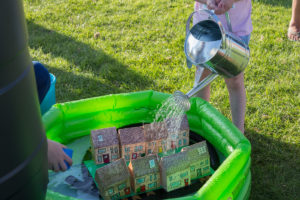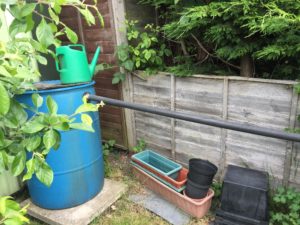Rainwater Harvesting
Dr Christine Sefton, Community Engagement Researcher, The University of Sheffield
Just to be clear, this article is not going to tell you anything new about how rainwater harvesting works, or even why it is important; my skills lie in communication, community engagement and community development. What I want to describe here is what people tell me about their rainwater harvesting experiences and how positively they feel about this:
“I like my water butt. I like it. I do, I use it a lot.” (Mrs M from Hull)
I think it is worth describing these experiences, because those of you who work in sustainable water management may be at the brunt of complaints and have to solve problems. It is therefore, not surprising that your perspective on public interest with all things watery can get a little negative. I suspect that you rarely have people proudly show you around their gardens, enthusing about the benefits of collecting and using rainwater:
“Oh, God, yes, it’s just better for the world. It’s better for everything. It wouldn’t cost me any more or less, but it would still save water in general.”
(Mrs D from Hull)
The project I most recently completed was the MOCA project – Mobilising Communities for Adaptation. This year-long research explored the feasibility of stimulating communities in Hull and East Riding to install and collectively empty rain tanks prior to extreme weather events in order to slow the flow of rainwater into the drainage system. The assumption of our practitioner collaborators, Living with Water, was that people would be motivated to participate by understanding their flood risk, and that participation was likely to be affected by differences in affluence.

Interactive activity aimed at children to demonstrate how rain water harvesting can help towards flood resilience. This activity was devised as part of the MOCA project (2019) University of Sheffield.
However, neither knowledge of flood risk or affluence determined whether residents participated in the research or were interested in taking part in a rain-tank flood resilience project. Amongst our 32 self-selected participants less than half had experienced direct flooding to their property, and between them they represented private and council estate tenants, homeowners, formally educated and self-educated, younger and older people, employed, self-employed, retired, those describing themselves as well-off and those who said they had to watch the pennies. The factor they did all have in common, was using, planning or desiring some sort of rainwater collecting system.
Not surprisingly, the main reason for wanting to collect rain was to water the garden, as one participant put it:
“If they’re interested in growing plants, then they’ve got to be interested in storing the water to do them plants.” (Mrs X Hull)
While many participants described the relative benefits of watering plants with rain rather than tap water, only a few spoke about saving money. One person intimated that collecting rainwater fitted with their pagan beliefs, another that it reminded them of their grandad. Parents said that they thought it was a good way for children to learn about the environment and gain respect for the elements.
Overwhelmingly, participants were positive about rainwater harvesting, and keen to share their individual systems, which were almost as varied as they were. From ambitious designs for a framework of multiple interconnected tanks installed on the back of a garage for irrigating the greenhouse, to large vases, pots and watering cans positioned strategically around the garden. Alongside conventional water butts, participants proudly described recycling old storage drums, broken wheelbarrows and off-cuts of guttering.

Upcycled storage drum connected to another recycled container with a piece of salvaged drainpipe, collecting rain from a domestic outbuilding roof.
Many of these ingenious systems circumnavigated problems people had with installing conventional domestic water butts. For example, lack of finance, lack of space or the need to get permission from a property owner to use the downpipe. Some participants lived in terraced housing with no down pipe at all. This last point led to one household sharing water butts with their neighbours – one had the space, the other had the pipe.
Listening to participants tell their stories of rain collecting provides insight into the potential enthusiasm people have for understanding and respecting water. It also indicates some of the barriers people face to engage with that tiny part of the natural water cycle for which they can have some responsibility. Inviting people to share their rainwater harvesting inventiveness is a good reminder that the public are about more than complaints, problems and disasters. Celebrating people’s rain collecting achievements, however unmeasured and unconventional, is a celebration of public engagement with sustainable water management.
Dr Christine Sefton
Building local flood resilience through cooperative rainwater harvesting: Mobilising Communities for Adaptation: (2019) Conducted by The Department of Urban Studies and Planning at the University of Sheffield in collaboration with Hull and East Riding ‘Living with Water’ Partnership and funded by ‘UK Research and Innovation’.